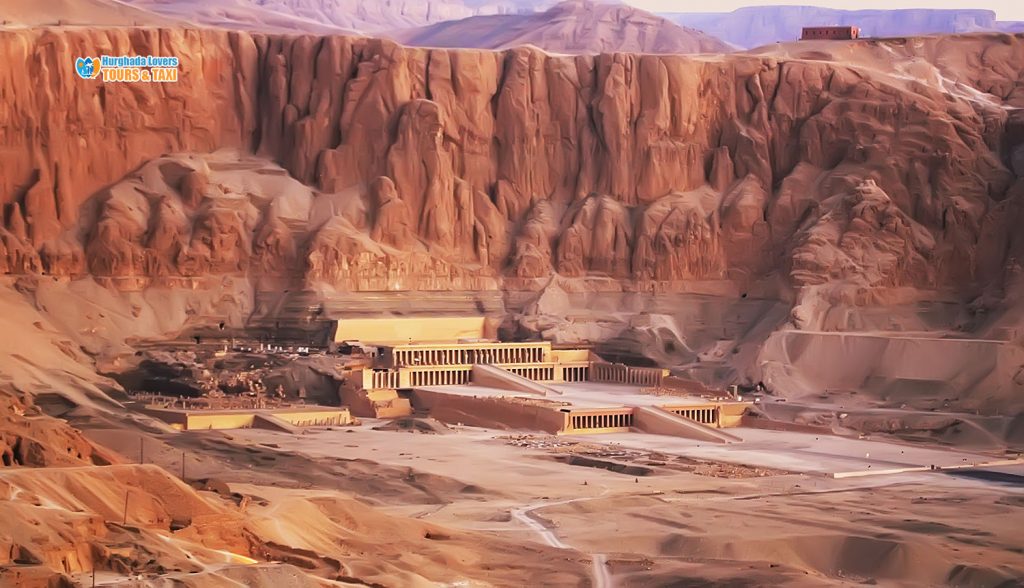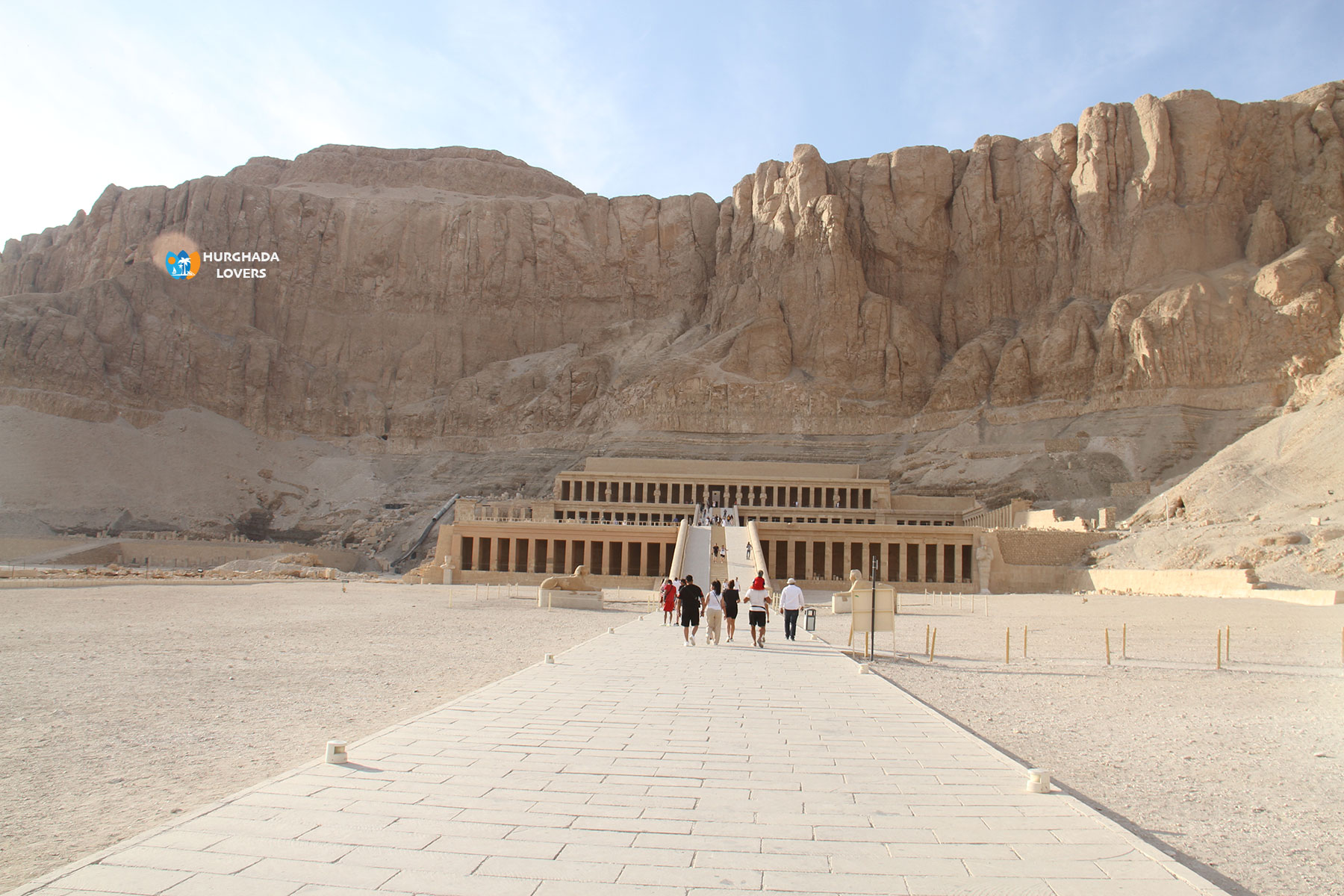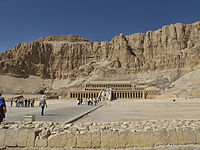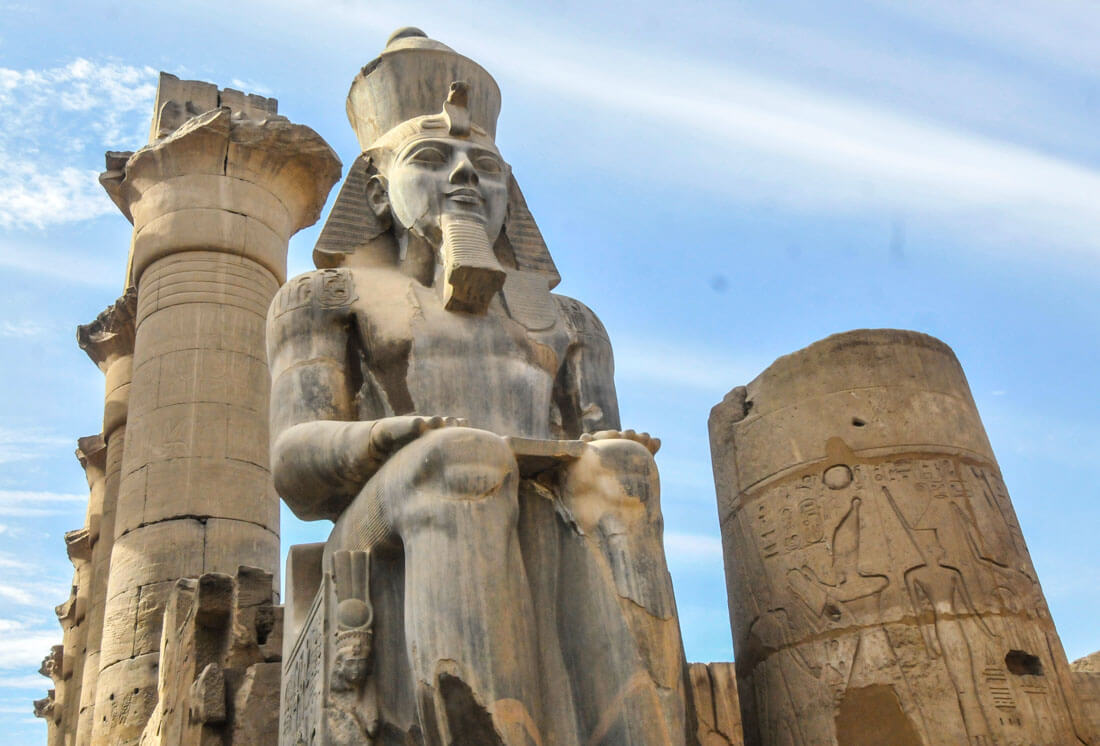Deir El-Bahari: A Must-See Temple in Luxor

If you're planning a trip to Luxor, Egypt, include a visit to the Deir El-Bahari temple on your itinerary. This stunning temple complex is a must-see attraction that will transport you back to ancient Egypt.
A brief overview of Deir El-Bahari temple
Deir El-Bahari, also known as the Temple of Hatshepsut, is located on the west bank of the Nile River in Luxor. It was built during the 15th century BC and is dedicated to the Egyptian pharaoh Hatshepsut. The temple is a masterpiece of ancient Egyptian architecture, with its terraces, colonnades, and intricate reliefs.
The temple complex consists of three terraces that rise above each other, creating a visually striking structure against the backdrop of the desert cliffs. The lower terrace features a large courtyard with statues and pillars, while the middle terrace houses chapels and shrines dedicated to various gods. You'll find the sanctuary and the famous Hathor chapel on the upper terrace.
Importance and historical significance
Deir El-Bahari temple holds great historical significance as it showcases the reign of Hatshepsut, one of Egypt's most powerful female pharaohs. Hatshepsut was known for her ambitious building projects and successful trade expeditions to other countries.
The temple's reliefs depict scenes from Hatshepsut's life and achievements, including her divine birth and role as a ruler. These reliefs provide valuable insights into ancient Egyptian culture and society.
Visiting Deir El-Bahari allows you to immerse yourself in the rich history of ancient Egypt and marvel at the architectural brilliance of this well-preserved temple. The grandeur and beauty of the temple complex are truly awe-inspiring, making it a must-visit destination for history enthusiasts and anyone interested in ancient civilizations.
So, when you're in Luxor, don't miss the opportunity to explore the Deir El-Bahari temple and experience the wonders of ancient Egypt firsthand.

Location and History
Location of Deir El-Bahari temple in Luxor
If you're planning a trip to Luxor, Egypt, include a visit to the stunning Deir El-Bahari temple on your itinerary. Located on the western bank of the Nile River, this ancient temple complex is situated in the Theban Necropolis, just opposite the city of Luxor.
Historical background and construction
Deir El-Bahari, meaning "Northern Monastery" in Arabic, was built during the 15th century BC as a mortuary temple for Pharaoh Hatshepsut, one of Egypt's most powerful female rulers. The temple was dedicated to the god Amun and served as a place to worship and commemorate Hatshepsut's reign.
The construction of this magnificent temple was a remarkable feat of engineering. Its design is unique, with terraces rising against the cliffs of the Theban Mountain. The temple's architecture blends harmoniously with the natural landscape, creating a breathtaking sight that has captivated visitors for centuries.
The walls of Deir El-Bahari are adorned with intricate reliefs depicting scenes from Hatshepsut's life and achievements. These reliefs provide valuable insights into the history and culture of ancient Egypt. Visitors can explore various chambers and halls within the temple complex, including the Sanctuary of Amun, which houses a sacred cult statue.
Today, Deir El-Bahari stands as a testament to the grandeur and sophistication of ancient Egyptian architecture. Its well-preserved ruins offer visitors a glimpse into the rich history of this remarkable civilization.
So, if you're fascinated by ancient history and architectural marvels, don't miss out on visiting Deir El-Bahari during your trip to Luxor. It's an experience that will leave you in awe of the ingenuity and artistry of the ancient Egyptians.
:max_bytes(150000):strip_icc()/Djeser-Djeseru-5910663e3df78c9283cb6375.jpg)
Architectural Marvels
Unique design and layout of the temple
If you plan a trip to Luxor, Egypt, visit Deir El-Bahari, a must-see temple that will leave you in awe. The temple's unique design and layout make it stand out among ancient Egyptian structures.
Deir El-Bahari is a masterpiece of Egyptian architecture built during the reign of Pharaoh Hatshepsut in the 15th century BC. It is located on the west bank of the Nile River and is carved into the cliffs of the Theban Mountain range. The temple's terraced structure creates a stunning visual effect and blends seamlessly with the natural surroundings.
The temple is divided into three levels, each dedicated to different deities. The lower level is dedicated to Amun-Ra, the middle level to Hathor, the goddess of love and joy, and the upper level to Anubis, the god of mummification. Each level has unique features and decorations, showcasing ancient Egypt's religious beliefs and rituals.
Impressive features and structures
One of the most impressive features of Deir El-Bahari is its collonaded terrace. This grand structure consists of rows of beautifully carved pillars that support a massive roof. Walking along this terrace will give you a sense of the grandeur and opulence that once existed in ancient Egypt.
Another notable structure is the Hathor Chapel, located on the middle level. This chapel is adorned with intricate reliefs depicting scenes from Hatshepsut's life and religious ceremonies. The walls are covered in vibrant colours that have miraculously survived thousands of years.
As you explore Deir El-Bahari, you will also come across various statues, obelisks, and sanctuaries that add to the temple's charm and historical significance. The attention to detail and craftsmanship displayed in these structures is truly remarkable.
Visiting Deir El-Bahari is not just a journey back in time but also an opportunity to appreciate the architectural genius of the ancient Egyptians. So, include this temple in your itinerary when you visit Luxor.

Temples and Shrines
Main temples and shrines within the Deir El-Bahari complex
If you are planning a trip to Luxor, Egypt, including a visit to the magnificent Deir El-Bahari temple complex. This ancient site is a must-see for history enthusiasts and those interested in ancient Egyptian culture. Here are the main temples and shrines you should explore within the complex:
-
The Mortuary Temple of Hatshepsut is dedicated to the female pharaoh Hatshepsut, who ruled Egypt during the 15th century BC. It is an architectural marvel, with its terraces built into the cliffs of the Theban mountains. The temple features stunning reliefs depicting the life and achievements of Hatshepsut.
-
The Temple of Mentuhotep II is older than the Mortuary Temple of Hatshepsut and was built during the 11th dynasty. It is dedicated to Mentuhotep II, a pharaoh who united Upper and Lower Egypt. The temple's architecture and decorations provide valuable insights into ancient Egyptians' religious beliefs and rituals.
-
The Temple of Amun is located within the Deir El-Bahari complex but is separate from the other two main temples. It is dedicated to the god Amun, one of the most important deities in ancient Egyptian religion. The temple's grandeur and intricate carvings make it a sight to behold.
Purpose and significance of each
Each temple within the Deir El-Bahari complex served a specific purpose and was significant in ancient Egyptian society. The Mortuary Temple of Hatshepsut was built as a funerary temple for Hatshepsut, showcasing her achievements and ensuring her eternal life in the afterlife.
On the other hand, the Temple of Mentuhotep II was built to honour the pharaoh who brought stability and unity to Egypt after a period of political turmoil. It served as a place for religious rituals and offerings to ensure the pharaoh's divine protection and guidance.
Lastly, the Temple of Amun was dedicated to the god Amun, who was associated with creation, fertility, and kingship. It was a place of worship and pilgrimage for ancient Egyptians, where they sought blessings and divine intervention in their lives.
Visiting these temples and shrines within the Deir El-Bahari complex will allow you to admire their architectural beauty and provide a deeper understanding of ancient Egyptian history and spirituality.
Wall Reliefs and Artwork
Detailed exploration of the intricate wall reliefs and artwork
When you visit Deir El-Bahari, one of the most captivating aspects is the intricate wall reliefs and artwork that adorn the temple's walls. These detailed carvings and paintings provide a fascinating glimpse into ancient Egyptian culture and history.
The craftsmanship and attention to detail in the reliefs are truly remarkable. The walls depict scenes depicting various aspects of daily life, religious rituals, and important historical events. As you explore the temple, take your time to appreciate the skill and artistry that went into creating these masterpieces.
Depictions of historical events and religious scenes
The wall reliefs at Deir El-Bahari also offer insights into ancient Egypt's significant historical events and religious beliefs. You'll find depictions of pharaohs engaging in battle, offering sacrifices to gods, and participating in religious ceremonies. These scenes provide a window into the political and religious life of the time.
Additionally, the temple's walls feature religious scenes showcasing various gods and goddesses worshipped by ancient Egyptians. These depictions allow you to learn more about their beliefs and rituals.
The combination of historical events and religious scenes on the walls creates a rich tapestry of ancient Egyptian culture. It's like stepping back in time and immersing yourself in a world that existed thousands of years ago.
So, when you visit Deir El-Bahari, take your time exploring the intricate wall reliefs and artwork. They offer a unique opportunity to connect with ancient Egyptian history and better understand their civilization.

Queen Hatshepsut and Her Legacy
Queen Hatshepsut's connection to Deir El-Bahari
If you are planning a trip to Luxor, Egypt, one place you must not miss is the magnificent temple of Deir El-Bahari. This temple holds great historical significance and is closely associated with the legendary Queen Hatshepsut.
Queen Hatshepsut, one of the most powerful female pharaohs in ancient Egypt, ruled during the 18th dynasty. She was known for her ambitious building projects, and her reign was marked by peace and prosperity. Deir El-Bahari was one of her most ambitious projects and was her mortuary temple.
Influence and achievements of the queen
Queen Hatshepsut's reign left a lasting impact on ancient Egypt. She was a visionary leader who promoted trade and initiated expeditions to distant lands, including the famous expedition to the land of Punt. Her achievements in architecture and art were remarkable, as seen in the grandeur of Deir El-Bahari.
The temple of Deir El-Bahari is a masterpiece of ancient Egyptian architecture. Its unique design features terraces, colonnades, and stunning reliefs depicting the queen's divine birth and successful reign. The temple also served as a place of worship for the goddess Hathor, associated with fertility, music, and joy.
Visiting Deir El-Bahari allows you to immerse yourself in the rich history of ancient Egypt and witness the legacy of Queen Hatshepsut. The grandeur and beauty of this temple will leave you in awe of the architectural prowess of the ancient Egyptians.
So, when planning your trip to Luxor, include Deir El-Bahari in your itinerary. It is a must-see destination that will transport you back in time and give you a glimpse into the remarkable achievements of Queen Hatshepsut.

Restoration and Conservation Efforts
Efforts to preserve and restore Deir El-Bahari temple
If you plan to visit Luxor, Egypt, include the Deir El-Bahari temple on your itinerary. This ancient temple, located on the west bank of the Nile River, is a must-see for history enthusiasts and architecture lovers alike. But what makes this temple even more remarkable is the ongoing restoration and conservation efforts that have been taking place over the years.
The Egyptian Ministry of Antiquities, in collaboration with international organizations and experts, has been working tirelessly to preserve and restore the Deir El-Bahari temple. These efforts aim to protect the temple from deterioration caused by natural elements and human activities.
The restoration process involves scientific research, documentation, and physical interventions. Experts use advanced technologies such as laser scanning and 3D modelling to accurately represent the temple's original state. This helps in understanding the structure and identifying areas needing repair or reinforcement.
Challenges and successes in the conservation process
Preserving an ancient temple like Deir El-Bahari has its fair share of challenges. The harsh climate, including extreme temperatures and occasional flooding, threatens the temple's delicate carvings and structures. The high number of visitors can also contribute to wear and tear over time.
Despite these challenges, the restoration efforts have seen significant successes. The meticulous work done by conservationists has resulted in the stabilization of crumbling walls, the reattachment of fallen reliefs, and the cleaning of intricate carvings. These efforts have preserved the temple's historical significance and enhanced its beauty for future generations to appreciate.
So when you visit Deir El-Bahari temple, take a moment to appreciate its grandeur and the dedication and expertise that have gone into its preservation. By supporting these restoration efforts, you contribute to this ancient treasure's continued protection and enjoyment.

Visiting Deir El-Bahari
If you're planning a trip to Luxor, Egypt, include a visit to Deir El-Bahari on your itinerary. This ancient temple complex is a must-see for history enthusiasts and architecture lovers. Here's everything you need to know to make the most of your visit.
Practical information for visitors
-
Location: Deir El-Bahari is located on the west bank of the Nile River, opposite Luxor.
-
Opening hours: The temple complex is open daily from 6 a.m. to 5 p.m.
-
Entrance fee: There is an entrance fee to access the site. Make sure to check the latest prices before your visit.
-
Guided tours: Consider hiring a knowledgeable guide who can provide insights into the history and significance of the temple complex.
-
Dress code: As with any religious site, it's important to dress modestly and respectfully. Avoid wearing revealing clothing or shorts.
Tips for a memorable visit
-
Plan your visit: Allocate enough time to explore the entire complex, as there are multiple temples and structures to see.
-
Bring water and snacks: It can get hot during the day, so stay hydrated and carry some snacks for energy.
-
Camera essentials: Don't forget your camera! The intricate carvings and stunning architecture of Deir El-Bahari are worth capturing.
-
Comfortable footwear: Wear comfortable shoes, as you'll be doing a fair amount of walking and climbing stairs.
-
Respect the site: Be mindful of the rules and regulations, and avoid touching or damaging ancient structures.
Visiting Deir El-Bahari is a journey back in time, allowing you to marvel at the craftsmanship and grandeur of ancient Egyptian architecture. So, add this incredible temple complex to your travel plans and create memories that will last a lifetime.
